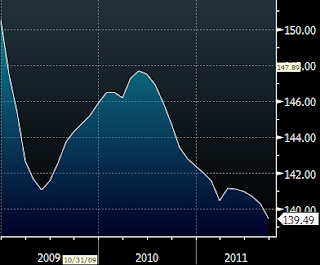According to CoreLogic, the US housing market continues to stay weak. After a reasonably stable summer, the housing pricing impacted by the global markets, have disappointed. The Case-Shiller Composite-20 seasonally adjusted index showed a post-summer decline as well - in fact touching new lows.
Case-Shiller Composite-20 SA: Source: Bloomberg
The situation looks quite gloomy going forward as well:
- Almost a quarter of all homes have “negative equity”
- The new lending criteria is quite restrictive
- The law surrounding loan sales is shifting (Massachusetts)
- Rules surrounding foreclosure remain uncertain
- A great deal of uncertainty still surrounds Fannie and Freddie as well as the FHA
Having said that, Capital Economics took the CoreLogic data, adjusted it for seasonality, and extracted data for homes that are “non-distressed”. The chart below shows month over month percent changes in price for the whole data set as well as the non-distressed component. The contrast between the two is quite sharp (down 3.2% YTD vs. up 0.2%).
That means the market may become bifurcated, with the non-distressed component doing somewhat better. This hypothesis is in part supported by the recent earnings results from Toll Brothers:
Reuters: Contracts for new homes rose 15 percent to 644, with a value of $390.0 million, up 24 percent. The average price of new homes under contract rose to $606,000 from $565,000 a year earlier. … Toll ended the quarter with a backlog of 1,667 homes under order, up 12 percent. The backlog was valued at $981.1 million, up 15 percent.The non-distressed housing stability can also be seen in new single-family home sales which are by definition "non-distressed":
Reuters: Sales of new single-family homes in October edged up 1.3 percent to a seasonally adjusted 307,000-unit annual rate, the fastest pace in five months, the department reported.This improvement in the non-distressed sector is obvously encouraging, but all bets are off should the US GDP take a turn for the worse next year. Unfortunately the price of one's home continues to be linked to the situation in Europe.
SoberLook.com














